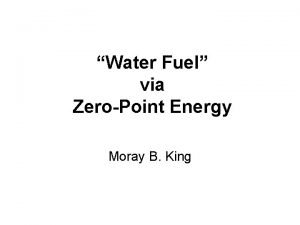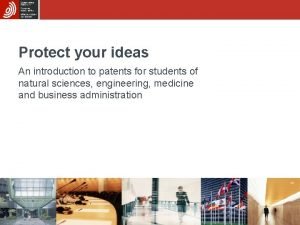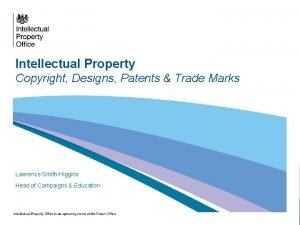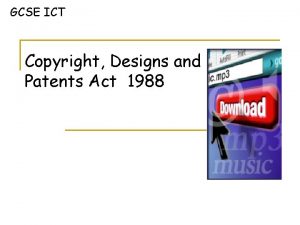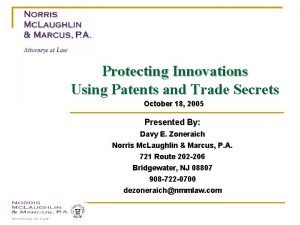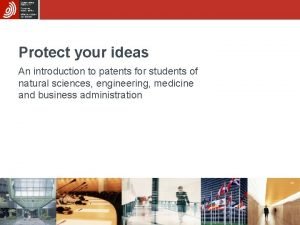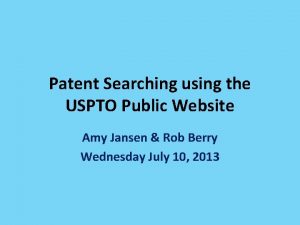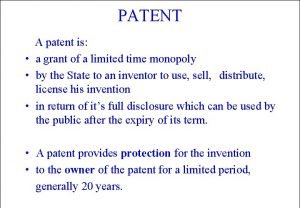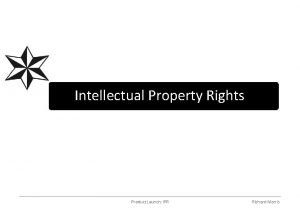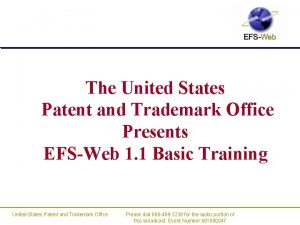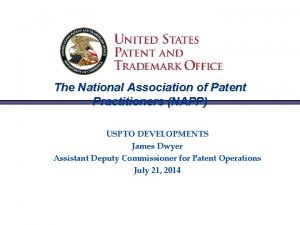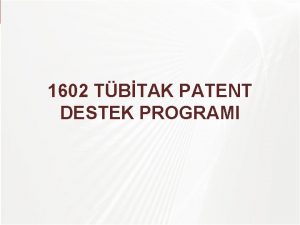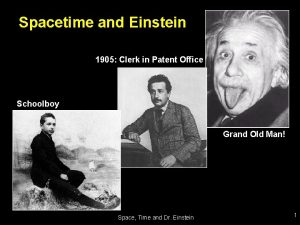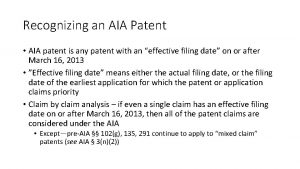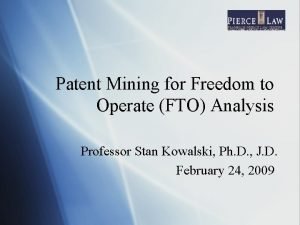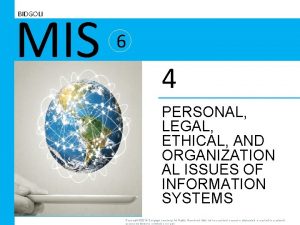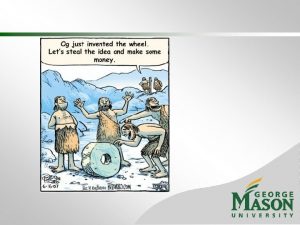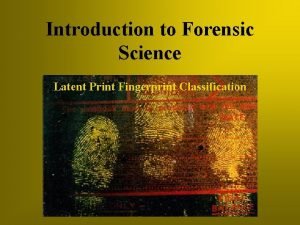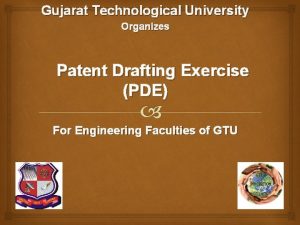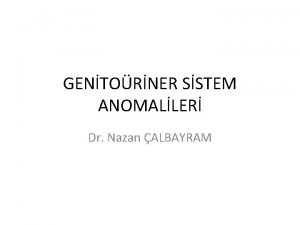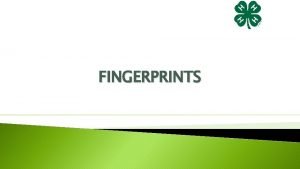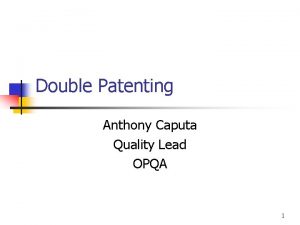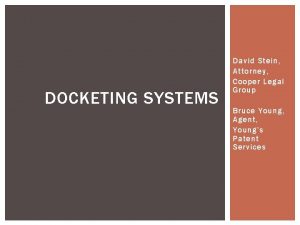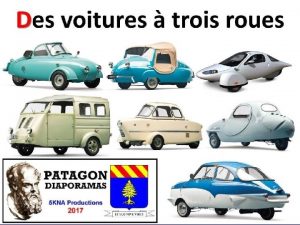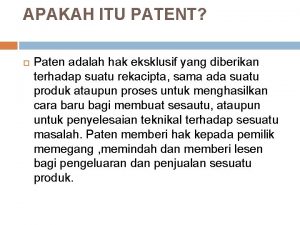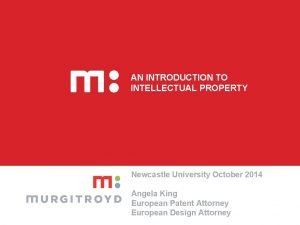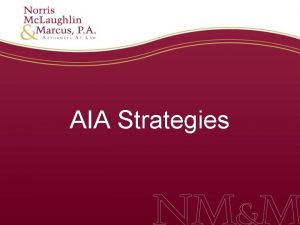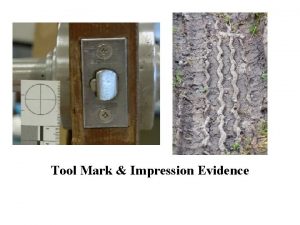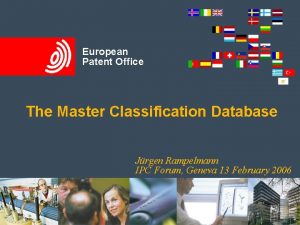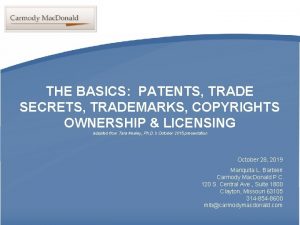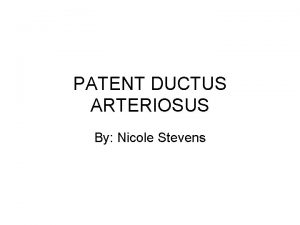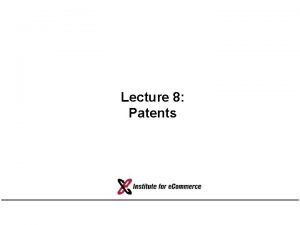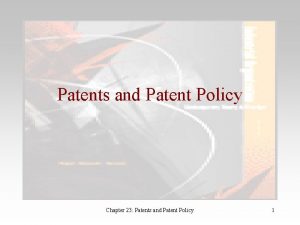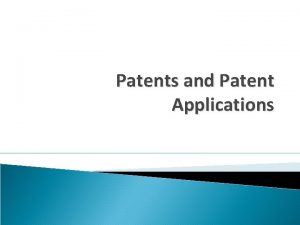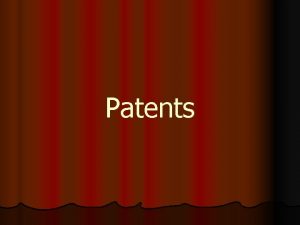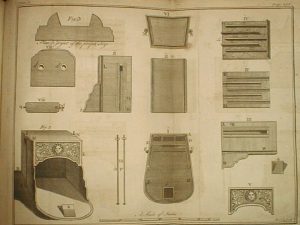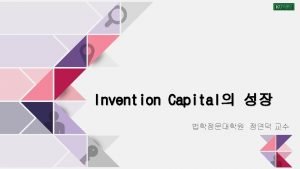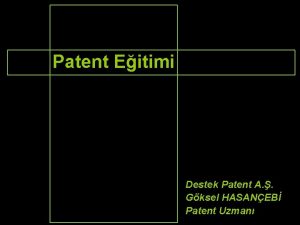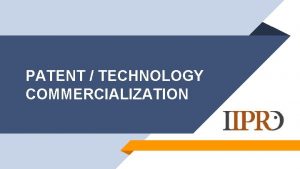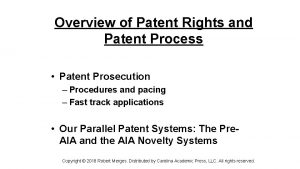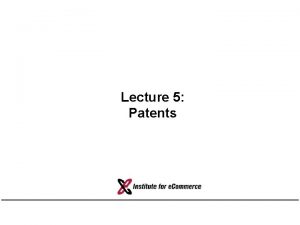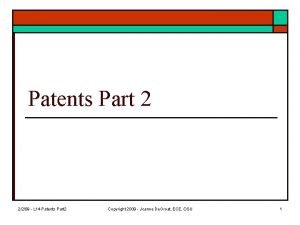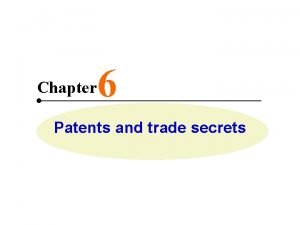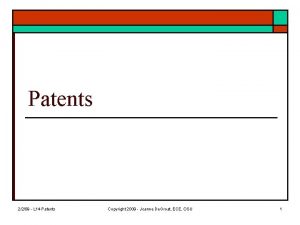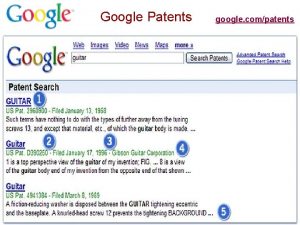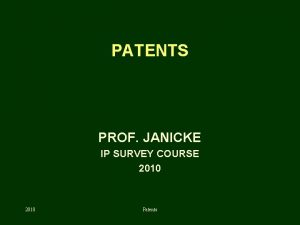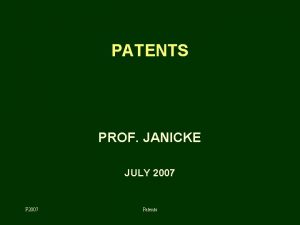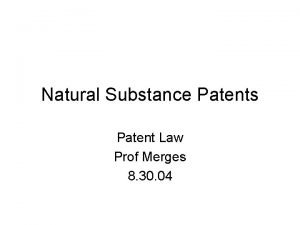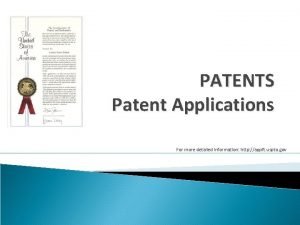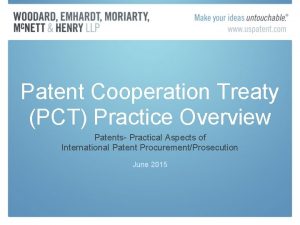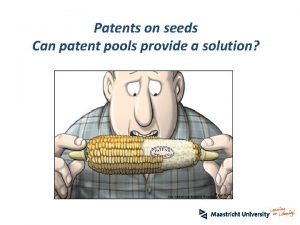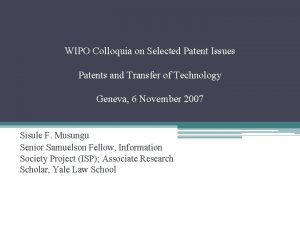Lecture 8 Patents Outline Whats a patent Patents









































- Slides: 41

Lecture 8: Patents

Outline • • • What’s a patent? Patents on business methods Lots of examples How are patents issued? How do invalid patents get issued?

Purpose of Patents • Encourage technological innovation by rewarding inventors • Allow society to benefit (build structural capital) • Natural justice theory: “Justice gives every man a title to the product of his honest industry. ” John Locke, Two Treatises on Civil Government (1690)

Rewarding Inventors • Pay them – Buy out invention – Pay royalties (Soviet Union) • Allow them freedom to exploit the invention • In the U. S. , confer a monopoly for 20 years • Compact theory: – You tell us all about your invention – We protect your ability to make money

Parts of a Patent • Specification – Must tell how to make and use the invention – Usually background (prior art) + need for the invention • Claims – One or more statements defining what the inventor regards as his invention(s) – Written in highly stylized language (“patentese”) that looks similar to English • Each claim is its own “mini-patent. ” • Infringing any one claim infringes the patent

Patent History • Patents date back to the Industrial Revolution • U. S. Patent Office founded: 1790 • Patents issued through May, 2004: 6, 742, 188 • Total patents issued per week, 2004: ~3400 • Internet-related patents issued per week, 2004: ~250

ISSUED MARCH 25, 2003 • Infringement is determined by reading the claim “on” the accused device

Electronic Television Program Guide with Calendar Tool U. S. Patent 6, 742, 184 ISSUED MAY 25, 2004

Electronic Television Program Guide with Calendar Tool U. S. Patent 6, 742, 184 ISSUED MAY 25, 2004

Automatic Mattress Selection System U. S. Patent 6, 741, 950 ISSUED MAY 25, 2004

Automatic Mattress Selection System U. S. Patent 6, 741, 950 ISSUED MAY 25, 2004

What is Patentable? “Whoever invents or discovers any new and useful 1. process, 2. machine, 3. manufacture, or 4. composition of matter, or 5. any new and useful improvement thereof, may obtain a patent therefor …” 35 U. S. C. § 101 If none of these 5, it’s not patentable.

What is Not Patentable? • • Unimplemented ideas Laws of nature: E = mc 2 Natural phenomena, substances Printed matter Mathematical formulas: Purely mental steps FORMERLY, “methods of doing business”

Extra Requirement of Non-Obviousness “A patent may not be obtained … if the. . . subject matter as a whole would have been obvious at the time the invention was made to a person having ordinary skill in the art to which said subject matter pertains. ” 35 U. S. C. § 103

What’s Obvious? • Conventional transformations and operations on objects: • “Negative rules of invention” – changing size – substituting a new material – making an apparatus portable – new use for old apparatus – omitting parts, moving parts around • Combining references – Need “suggestion to combine”

Obviousness • Obviousness is not a subjective standard • The examiner cannot reject a claim because he thinks it is obvious or that it seems elementary • A reference to the prior art MUST be furnished

Obviousness To establish … obviousness, three basic criteria must be met: 1. There must be some suggestion or motivation, either in the references themselves or in the knowledge generally available to one of ordinary skill in the art, to modify the reference or to combine reference teachings. 2. There must be a reasonable expectation of success. 3. The prior art reference (or references when combined) must teach or suggest all the claim limitations. The teaching or suggestion to make the claimed combination and the reasonable expectation of success must both be found in the prior art and not based on applicant's disclosure. Manual of Patent Examining Procedure 706. 02(j)

The Patent Process • Search, e. g. USPTO • Application – Specification (+ “best mode”) – Claims • Examination – Comparison with “prior art” • Amendment – But no “new matter” • Issuance (term = 20 years from filing date) • Maintenance Fees • Enforcement (patents can be found invalid in ligitation)

Patent Applications • • Pursuing a patent application is called “prosecution” Assigned to an examiner Examiner performs a “prior art” search Prosecution is a negotiation between PTO and applicant – clarity of specification, arguments over obviousness, wording of claims • Usually takes 9 months to 2 years • Application can be amended, but no “new matter” can be added

US 6, 019, 393, issued Feb. 1, 2000 Planar means for indicating a gratuity as a function I claim: 1. An article of manufacture comprising a gratuity sheet to enable a customer in a restaurant or the like to record the value of an optional gratuity as a function of the cost of the meal; said gratuity sheet comprising a planar sheet having displayed thereon a first set of indicator means for defining a second set of indicator means for representing the gratuity as a percentage function. “PRINTED MATTER” LITTLE CHANCE THIS IS A VALID CLAIM

US 6, 019, 393, issued Feb. 1, 2000 Planar means for indicating a gratuity as a function IMPROVEMENT CLAIM TO A PEN COMPUTER – MAY BE VALID: 5. In an article of manufacture comprising a pen computer used in a restaurant or the like to record the cost of at least one meal and at least one optional gratuity, said pen computer comprising (A) at least one planar surface defining a coextensive information receiving and information display surface; (B) means for internal digital storage of data and program instructions; (C) processor means to execute said instructions; (D) display means to display said internally stored data upon said planar surface; and (E) stylus detection means for recording the x, y position of a stylus relative to said planar information receiving surface; the improvement comprising (F) means to input the value of said at least one gratuity as both a percentage function of the cost of the at least one meal and as an absolute monetary value; and (G) processing and display means to display upon said planar surface the value of the gratuity both (H) as a percentage and (I) as an absolute monetary amount.

Methods of Doing Business • The term ‘business method’ means— • (1) a method of— (A) administering, managing, or otherwise operating an enterprise or organization, including a technique used in doing or conducting business; or • (B) processing financial data; • (2) any technique used in athletics, instruction, or personal skills; and • (3) any computer-assisted implementation of a method described in paragraph (1) or a technique described in paragraph (2). 35 U. S. C. § 100 (PROPOSED)

Methods of Doing Business • A “method of doing business” is patentable if it is one of the five types of invention: process, machine, manufacture, composition of matter, improvement • State Street Bank & Trust Co. v. Signature Financial Group, Inc. , 149 F. 3 d 1368 (Fed. Cir. 1998) (re patent no. 5, 193, 056) • “As an alternative ground for invalidating the '056 patent under § 101, the court relied on the judicially-created, so-called ‘business method’ exception to statutory subject matter. We take this opportunity to lay this ill-conceived exception to rest. ” • “The business method exception has never been invoked by this court … to deem an invention unpatentable. ”

The State Street Patent, No. 5, 193, 056 1. A data processing system for managing a financial services configuration of a portfolio established as a partnership, each partner being one of a plurality of funds, comprising: (a) computer processor means for processing data; (b) storage means for storing data on a storage medium; (c) first means for initializing the storage medium; (d) second means for processing data regarding assets in the portfolio and each of the funds from a previous day and data regarding increases or decreases in each of the funds, assets and for allocating the percentage share that each fund holds in the portfolio; (e) third means for processing data regarding daily incremental income, expenses, and net realized gain or loss for the portfolio and for allocating such data among each fund; (f) fourth means for processing data regarding daily net unrealized gain or loss for the portfolio and for allocating such data among each fund; and (g) fifth means for processing data regarding aggregate year-end income, expenses, and capital gain or loss for the portfolio and each of the funds.

Amazon. com v. Barnesand. Noble. com U. S. Patent 5, 960, 411 issued Sept. 28, 1999, suit filed Oct. 22, 1999 preliminary injunction issued Dec. 1999 injunction vacated on appeal Feb. 2001 CO-INVENTOR: JEFF BEZOS 1. A method of placing an order for an item comprising: • under control of a client system, • displaying information identifying the item; and • in response to only a single action being performed, sending a request to order the item along with an identifier of a purchaser of the item to a server system; • under control of a single-action ordering component of the server system, • receiving the request; • retrieving additional information previously stored for the purchaser identified by the identifier in the received request; and • generating an order to purchase the requested item for the purchaser identified by the identifier in the received request using the retrieved additional information; and • fulfilling the generated order to complete purchase of the item whereby the item is ordered without using a shopping cart ordering model.

Calendar Producing System “Calendars generally show dates of January through December, and users usually purchase them at the end of the previous year. However, the calendars need to be produced according to the demand for the end of the year, and some users can not get the desired calendars since the demand exceeds the supply at the end of the year. ”

US 6, 536, 965, issued Mar. 25, 2003 Calendar producing system, producing method, selling system and selling method 1. A calendar producing system comprising: • a server that stores information of a plurality of pictures; • a terminal that receives information of the plurality of pictures from the server and shows the information to a user, the user selecting pictures for a calendar from the plurality of pictures according to the information with the terminal to order the calendar; and • a printing office that receives information of the pictures selected by the user from the server and prints the calendar with the pictures selected by the user and a sequence of dates automatically set according to a date of the order OWNER: FUJI

Restricting Deep Hyperlinking WEBSITE REFERRING PAGE: page. html • DEEP LINK “Deep hyperlinks point directly to Web pages or other content of a different Web site. This may possibly result in bypassing the advertising-rich home pages or other identifying pages for the different Web site. Also, the original source, i. e. , the content provider, of the content of a deep link can become obscure. ” “Also, if advertising-rich home pages are bypassed, then the owner of those sites may suffer diminished revenue. ”

US 6, 539, 424, issued Mar. 25, 2003 Restricting deep hyperlinking on the World Wide Web 1. A computer program on a computer usable medium having computer readable program code means, comprising: • means for receiving a request for a desired page deeply linked within other pages; • means for sending a higher level page, in response to the request, along with an indication of a next page having a next sequential link to subsequently reach the desired page; and • means for repeatedly sending the next page, in response to each request for the next page from the client, along with an indication of a subsequent page having a subsequent link for the client to follow, until the desired page has been sent. OWNER: IBM

Against Internet Patents • Many bogus patents are issued • Patents prevent innovation • The Internet is a new technology. It needs growth, not restriction • Patents reward the wealthy, concentrate control over technology • The 20 -year patent term is far too long for the Internet • Technology patents often obtained by foreign companies

2003 Top 10 U. S. Patentees 2002 Stats 1. IBM (3415) (1, 3288) 2. Canon (1992) (2, 1893) 3. Hitachi (1893) (5, 1502) 4. Matsushita (1786) (6, 1544) 5. HP (1385) (9, 1385) 6. Micron (1707) (3, 1833) 7. Intel (1592) (-, -------) 8. Philips (1353) (-, -------) 9. Samsung (1313) (-, -------) 10. Sony (1311)(7, 1184) SOURCE: FACT-INDEX. COM 45 -848 ECOMMERCE LEGAL ENVIRONMENT SPRING 2004 COPYRIGHT © 2004 MICHAEL I. SHAMOS

What is a Patent? “Every patent shall contain … a grant to the patentee … of the right to exclude others from • making, • using, • offering for sale, or selling the invention throughout the United States or • importing the invention into the United States. ” 35 U. S. C. § 154 (Term: 20 years from application date)

U. S. Patent System U. S. SUPREME COURT PATENT SYSTEM IS FEDERAL ONLY APPEAL BY PETITION PATENT APPLICATIONS Can declare patents invalid COURT OF APPEALS FOR THE FEDERAL CIRCUIT APPEAL AS OF RIGHT (A Federal Executive Branch Agency) (Judicial Branch) U. S. DISTRICT COURTS (91) U. S. PATENT AND TRADEMARK OFFICE BOARD OF PATENT APPEALS AND INTERFERENCES PATENT EXAMINERS (2000) PATENT INFRINGEMENT CASES

Who Owns a Patent? • Employer – Non-inventive employee • Employer may have a “shop right” – Specifically inventive • Employer owns specific invention – Generally inventive • Employer owns all inventions pertinent to his business

Major Ideas • Good patents are good; bad patents are bad • Fast-moving technologies need incentives as much as slow-moving ones • Obviousness can be (should be) difficult to demonstrate • Solving the problem: improve the patent examination process

Q&A 45 -848 ECOMMERCE LEGAL ENVIRONMENT SPRING 2004 COPYRIGHT © 2004 MICHAEL I. SHAMOS

Priceline Online Bidding Patent U. S. Patent 5, 794, 207 Priceline. com v. Microsoft Corp. (re Expedia. com) (D. Conn. , filed 10/13/99) 1. A method for using a computer to facilitate a transaction between a buyer • • and at least one of sellers, comprising: inputting into the computer a conditional purchase offer which includes an offer price; inputting into the computer a payment identifier specifying a credit card account, the payment identifier being associated with the conditional purchase offer; outputting the conditional purchase offer to the plurality of sellers after receiving the payment identifier; inputting into the computer an acceptance from a seller, the acceptance being responsive to the conditional purchase offer; and • providing a payment to the seller by using the payment identifier.

Amazon. com Referral Patent U. S. Patent 6, 029, 141, Issued Feb. 22, 2000 1. A method of selling items with the assistance of associates, the method comprising: • providing a Web site system that includes a browsable catalog of items and provides services for allowing customers to electronically purchase the items; • providing an associate enrollment system which allows users to electronically apply to operate as associates that select and recommend items from the catalog and refer customers to the Web site system in exchange for compensation; • in response to a submission to the enrollment system by a user, assigning an associate identifier to the user and recording the associate identifier within a computer memory; • electronically providing to the user instructions for generating hypertextual documents with itemspecific links that, when selected by a customer, cause the user's associate identifier and an identifier of a recommended item to be transmitted to the Web site system in a request message; • receiving a request message which contains an associate identifier and an item identifier and extracting the associate and item identifiers from the message, the request message generated by a computer of a customer in response to selection by the customer of an item-specific link provided by an associate in conjunction with a recommendation of the item; • transmitting to the customer's computer a Web page which corresponds to the item identifier extracted from the request message; • transacting a sale of the item and/or other items of the catalog with the customer through the Web site system; • using the associate identifier extracted from the request message to identify the associate; and • determining and recording within a computer memory compensation for the associate for the sale.

Priceline Airline Ticket Patent U. S. Patent 5, 897, 620. Issued April 27, 1999 1. A method comprising the steps of: • viewing, using a computer, special fare listing information for air travel to a specified destination location from a specified departure location within a specified time range, said special fare listing information excluding a specified departure time; • transmitting, using a computer, a request to purchase a commitment for carriage corresponding to said special fare listing information; • receiving a commitment for carriage, including an obligation by an airline to provide a seat on a flight, that satisfies said request but does not specify a departure time; • accepting said commitment for carriage; and • receiving at a time subsequent to said accepting an identification of said departure time.

US 6, 209, 130, issued Mar. 27, 2001 System for collecting television program data 1. A system for electronically collecting program data over a data network, comprising: • a facility with a database of program data that is provided to multiple television distribution facilities for use in electronic program guides; and • a plurality of television system computers at which program schedules are constructed for submission to the facility by accessing program data at the facility database over the data network.

US 6, 208, 996, issued Mar. 27, 2001 Mobile device having notification database 1. A method of maintaining a notification database in a mobile device, the mobile device including a notification system which accesses entries in the notification database and causes user notifications to be presented based on the entries in the notification database, the method comprising: • running a notification scheduling program at a predetermined time, the notification scheduling program being configured to perform the following steps; • obtaining information indicative of a plurality of notifications to be presented in the future; • entering in the notification database only those notifications, of the plurality of notifications, which are to be presented within a limited predetermined time period; and • scheduling the notification scheduling program to be rerun in response to expiration of the limited predetermined time period.
 Whats a patent
Whats a patent 01:640:244 lecture notes - lecture 15: plat, idah, farad
01:640:244 lecture notes - lecture 15: plat, idah, farad Stanley meyer
Stanley meyer Simproved harry potter world
Simproved harry potter world What is the copyright designs and patents act 1988
What is the copyright designs and patents act 1988 What is the copyright designs and patents act 1988
What is the copyright designs and patents act 1988 Types of patents
Types of patents Advantages and disadvantages of patents
Advantages and disadvantages of patents Different types of patents
Different types of patents Insecticide act
Insecticide act Patents
Patents Lecture outline example
Lecture outline example Lecture outline example
Lecture outline example Lecture outline example
Lecture outline example Lecture outline meaning
Lecture outline meaning Sentence outline
Sentence outline Whats hot whats not
Whats hot whats not Patent electronic business center
Patent electronic business center National association of patent practitioners
National association of patent practitioners English royal patent of 1662
English royal patent of 1662 Tübitak patent desteği
Tübitak patent desteği Patent quality metrics
Patent quality metrics Einstein patent clerk
Einstein patent clerk Patent effective filing date
Patent effective filing date Fto patent
Fto patent Mis bidgoli
Mis bidgoli Trademark and trade secret
Trademark and trade secret Sufficient recurve
Sufficient recurve Pde form 2 gtu
Pde form 2 gtu Simpisis pubis
Simpisis pubis Fingerprints
Fingerprints Opqa
Opqa Cooper legal group
Cooper legal group Voiture aptera
Voiture aptera Apa itu paten
Apa itu paten Patent attorney newcastle
Patent attorney newcastle Asian patent attorneys association
Asian patent attorneys association Patent effective filing date
Patent effective filing date Tool mark impressions
Tool mark impressions Mcd in patent
Mcd in patent Nike com patent virtual marking
Nike com patent virtual marking Ductus arteriosus
Ductus arteriosus


